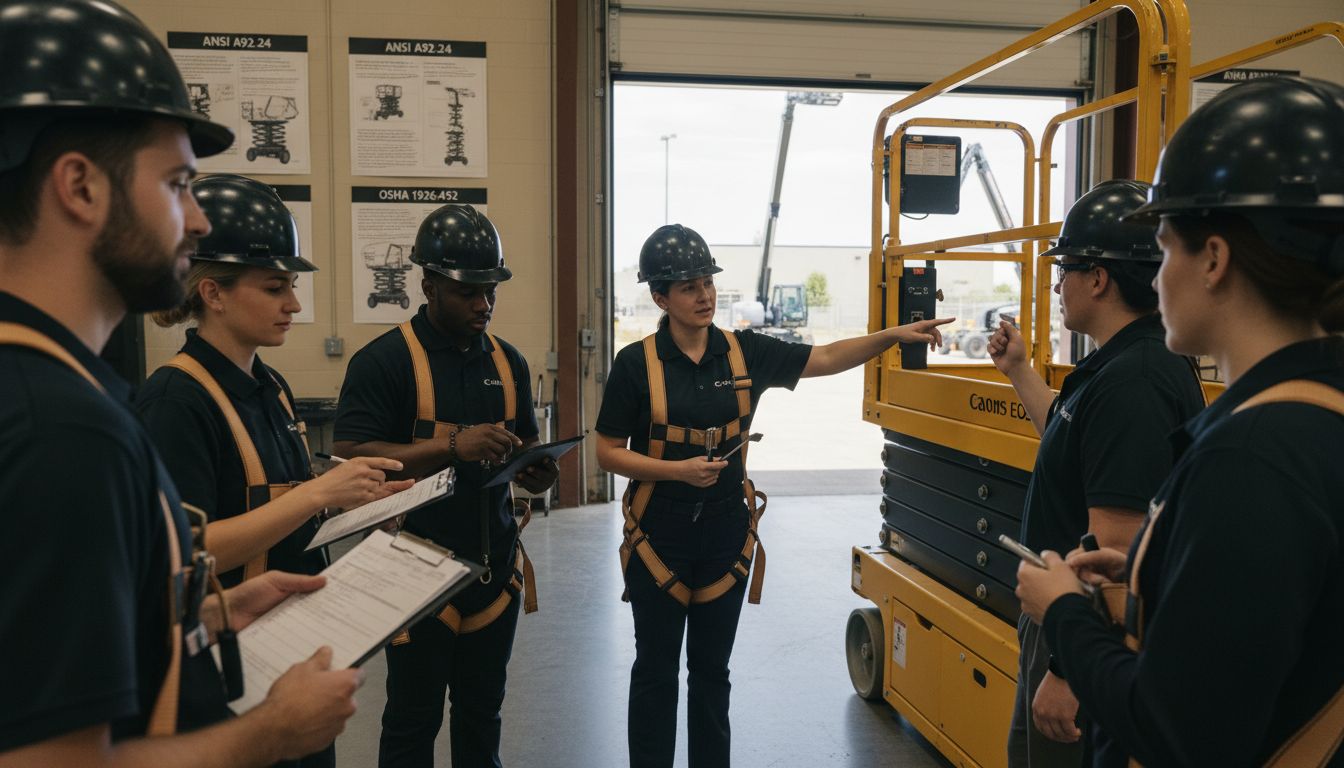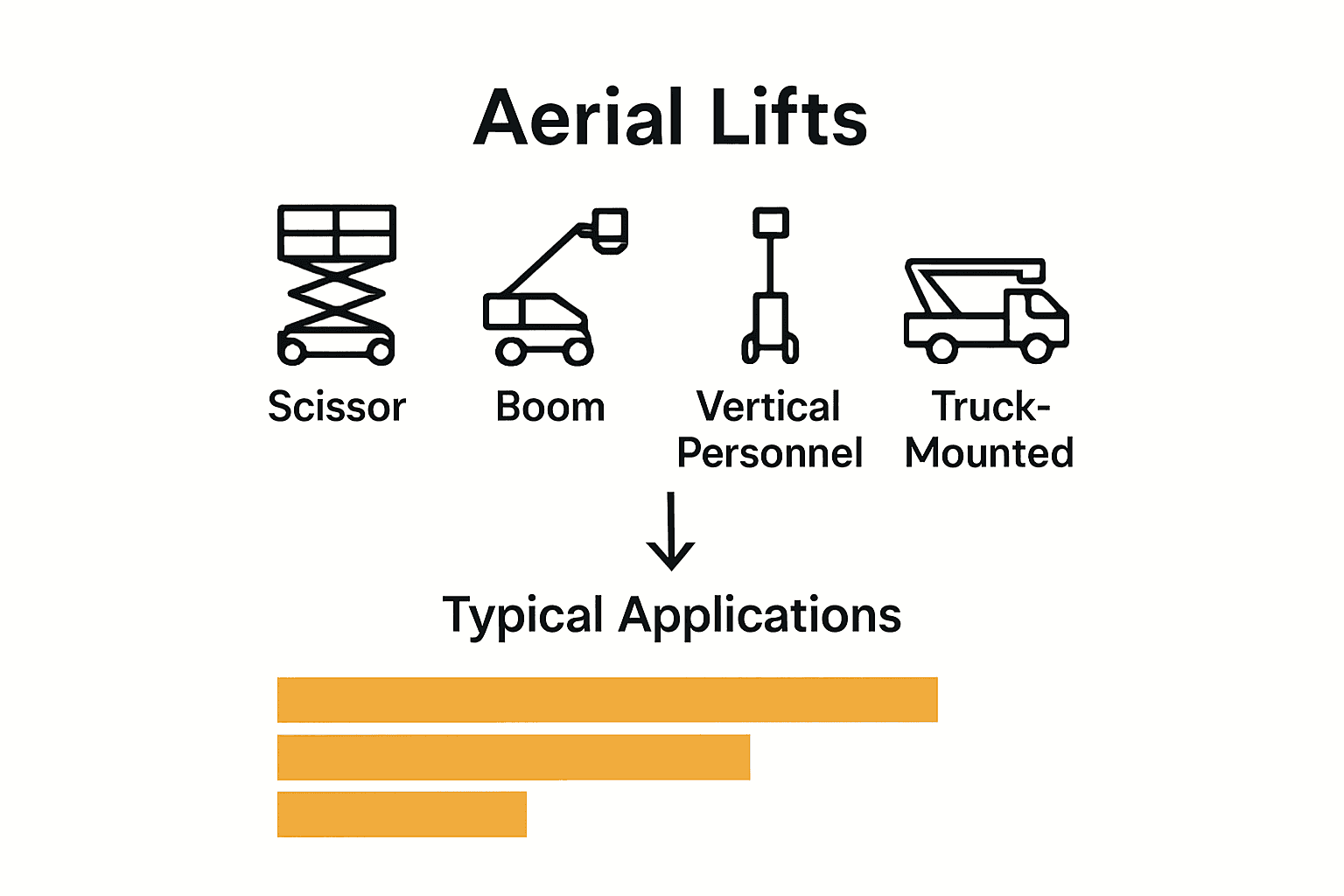
Falls from height are one of the leading causes of serious workplace injuries, yet many can be prevented with the right training. As aerial lifts replace traditional ladders and scaffolding, the need for proper education becomes urgent. More than 20 percent of fatal construction falls involve aerial lifts. Learning the standards, risks, and core skills around these machines helps protect workers and supports a safer work environment for everyone on the job.
| Point | Details |
|---|---|
| Aerial Lift Training Importance | Comprehensive training is essential for safe operation, covering hazard recognition, equipment use, and emergency procedures. |
| Certification Requirement | Operator certification is legally mandated and ensures only qualified personnel operate aerial lifts. |
| Common Compliance Risks | Organizations must address risks such as inadequate inspections and improper PPE use to enhance workplace safety. |
| OSHA Guidelines | Adhering to OSHA regulations significantly reduces legal liability and promotes a culture of safety and operational excellence. |
Aerial lift training is a specialized safety education program designed to prepare workers for the safe operation of elevated mobile platforms in professional settings. According to OSHA, aerial lifts are vehicle-mounted devices used to elevate personnel, including extendable boom platforms, aerial ladders, articulating boom platforms, and vertical towers. These sophisticated pieces of equipment have progressively replaced traditional access methods like ladders and scaffolding on many job sites due to their enhanced mobility and operational flexibility.
The primary purpose of aerial lift training goes far beyond simple equipment operation. As CDC emphasizes, these powered mobile platforms expose workers to significant fall hazards, making comprehensive safety education absolutely critical. Training programs comprehensively cover multiple essential dimensions, including:
Professional aerial lift training transforms novice workers into skilled, safety-conscious operators capable of navigating complex workplace environments. By providing in-depth knowledge about equipment mechanics, workplace regulations, and risk management, these programs ensure that workers can confidently and safely perform elevated tasks across various industries such as construction, maintenance, warehousing, and telecommunications.

Aerial lifts represent a diverse category of specialized mobile elevating work platforms designed for various industrial and construction applications. OSHA identifies several primary types of aerial lifts, each with unique operational characteristics and specific safety requirements. These include extensible boom platforms, aerial ladders, articulating boom platforms, vertical towers, and combinations of these innovative devices.
The primary aerial lift categories can be broken down into distinct types:
Here’s a summary comparing key types of aerial lifts and their common uses:
| Aerial Lift Type | Main Features | Typical Applications |
|---|---|---|
| Scissor Lift | Vertical movement Large platforms | Construction Warehousing |
| Boom Lift | Extendable arm High reach and flexibility | Building maintenance Utilities |
| Vertical Personnel Lift | Compact Narrow spaces | Indoor repairs Retail |
| Truck-Mounted Lift | Mobile Vehicle-mounted | Roadwork Telecom |
Certification for aerial lift operators is not optional—it’s a critical safety requirement. OSHA regulations mandate that only authorized personnel can operate these complex machines, with strict guidelines about operator qualifications and equipment modifications. Certification typically involves comprehensive training that covers equipment-specific operational techniques, safety protocols, hazard recognition, and practical skills assessment.
Operators must typically complete multiple certification levels, which progress from basic awareness to advanced operational expertise.

OSHA’s regulatory framework for aerial lift operations establishes comprehensive safety guidelines that are critical for workplace protection. OSHA standard 1926.453 provides explicit directives, emphasizing that only authorized personnel can operate aerial lifts and mandating that any equipment modifications must be officially certified to meet stringent safety standards.
The legal standards encompass multiple critical dimensions of aerial lift safety:
Employer responsibilities are equally rigorous. OSHA regulations require employers to proactively protect workers from potential aerial lift hazards through comprehensive safety strategies. This includes ensuring proper equipment maintenance, implementing thorough training programs, and maintaining strict adherence to established safety protocols. Non-compliance can result in significant financial penalties and potential legal liability.
Navigating these complex legal requirements demands a systematic approach. Understanding OSHA compliance is not just about avoiding penalties—it’s about creating a culture of safety that protects workers and promotes operational excellence across industries that rely on aerial lift equipment.
An effective aerial lift training program goes far beyond basic instruction—it’s a comprehensive safety ecosystem designed to protect workers and prevent workplace accidents. OSHA provides detailed guidance, emphasizing that training must comprehensively cover multiple critical dimensions of aerial lift operation and safety awareness.
The core components of a robust training program include:
CDC research underscores that training is not optional—it’s a critical intervention to prevent workplace injuries. Effective programs must integrate theoretical knowledge with practical, hands-on experience, ensuring operators can confidently navigate real-world challenges and potential hazards.
Successful training transcends mere compliance—it cultivates a culture of safety and operational excellence. Understanding train-the-trainer programs can help organizations develop sustainable, comprehensive safety education strategies that protect workers and minimize workplace risks.
Aerial lift operations are fraught with potential hazards that can quickly transform a routine task into a catastrophic incident. CDC research identifies multiple critical risks that operators and employers must proactively address, including falls from elevated levels, objects falling from lifts, tip-overs, platform ejections, structural failures, electric shock, entanglement hazards, and dangerous contacts with overhead objects.
The most prevalent compliance risks and operational mistakes include:
OSHA regulations mandate that employers must meticulously inspect work zones, eliminate potential hazards, and implement rigorous corrective actions before and during aerial lift operations. Compliance is not just about avoiding penalties—it’s about creating a comprehensive safety ecosystem that protects workers from preventable accidents.
Navigating these complex safety requirements demands a proactive and systematic approach. By understanding and addressing these common mistakes, organizations can significantly reduce workplace risks and create a culture of safety that prioritizes worker protection and operational excellence.
Falling hazards and equipment misuse are serious risks when operating aerial lifts. This article highlights the importance of specialized training to become an authorized, confident operator who understands vital safety protocols, hazard recognition, and OSHA compliance. If you want to avoid common mistakes like inadequate inspections or improper PPE use, you need more than just theory—you need comprehensive, hands-on education tailored to your industry’s needs.
Gain peace of mind and protect your team by investing in trusted aerial lift and scissor lift certification programs. At Forkliftacademy.com, you can access OSHA-compliant training courses designed for safety-conscious professionals. Whether you seek individual certification or business-wide solutions like train-the-trainer kits, our resources ensure every operator is prepared to meet legal standards and workplace risks.
Take the first step toward safer, smarter aerial lift operation today. Explore detailed training programs at our Forklift Certification Archives and build a culture of safety backed by real expertise. Visit Forkliftacademy.com now and transform how your team works at heights.
Aerial lift training is a specialized safety education program that prepares workers for the safe operation of elevated mobile platforms. It includes instruction on operational techniques, hazard recognition, and safety protocols.
Aerial lift training is critical because it addresses significant fall hazards associated with operating mobile platforms. It ensures that operators understand safety guidelines, perform necessary inspections, and use proper personal protective equipment (PPE).
Certification is required for various types of aerial lifts, including scissor lifts, boom lifts, vertical personnel lifts, and truck-mounted lifts. Operators must follow OSHA regulations that mandate training and certification.
Common compliance risks include inadequate pre-operation inspections, improper use of PPE, exceeding load capacity, insufficient operator training, and neglecting maintenance protocols. Addressing these risks is essential to maintaining a safe working environment.